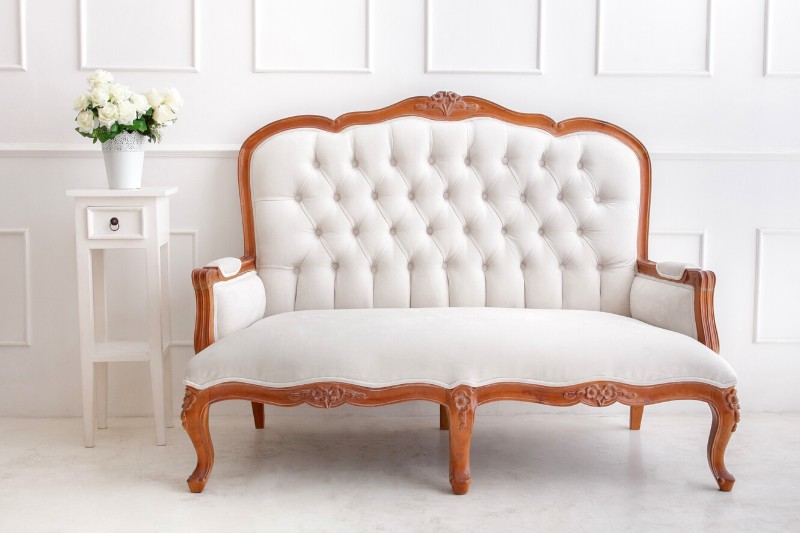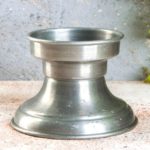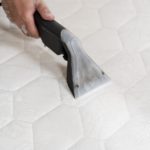Keeping your upholstery clean is important for several reasons. Not only for the appearance and longevity of the piece of furniture, but also to maintain a healthy home.
Dirt, dust and crumbs can quickly accumulate on fabric surfaces, leading to a buildup of bacteria and allergens.
Thankfully, regular upholstery cleaning should help to keep your sofa or armchair free from grime and unpleasant odours. But what’s the best way to go about it?
Read on to learn how to clean upholstery like a pro, and keep it looking and smelling good for longer.
What Should You Clean Upholstery With?
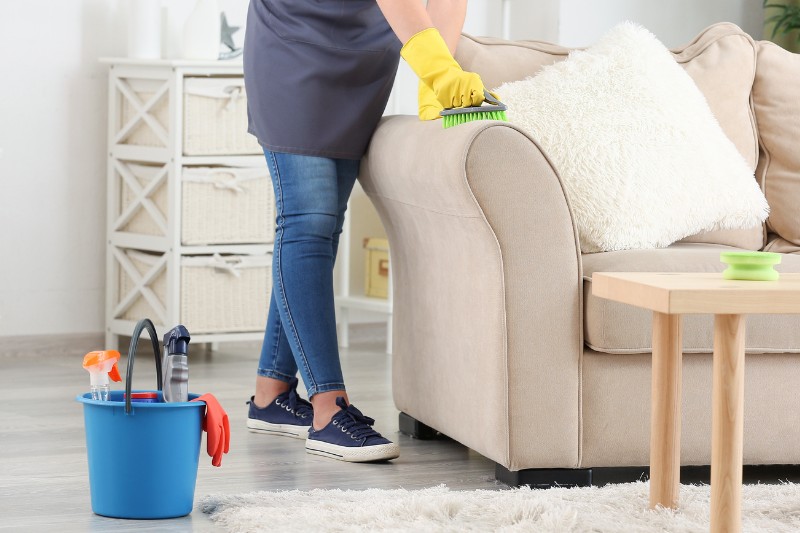
What to clean your upholstery with will depend on the fabric type. For instance, velvet and suede sofas are more delicate than cotton and microfibre models.
With that in mind, start by checking the care label to determine its upholstery cleaning code.
Materials rated “W” can be cleaned safely with water-based upholstery cleaners. However, those marked “S” must be treated with dry, solvent-based cleaners like Tableau Spot Remover or All Purpose Rubbing Alcohol only.
If there is an “X” on the care tag, you should not apply any cleaning products, as these could damage the fabric permanently. Instead, stick to regular brushing and vacuuming to keep dirt and debris at bay. And if a more thorough clean is needed, contact a professional for advice.
On the other end of the spectrum, you may find that your sofa covers are machine washable. In this case, simply remove them and follow the directions on the care label.
This will typically involve a cool delicates cycle and air drying, to avoid shrinking or warping. If in doubt, see our tips on washing sofa covers.
What’s the Easiest Way to Clean Upholstery Fabric?

The easiest way to keep fabric upholstery fresh is to carry out regular maintenance cleans. This includes vacuuming your sofas and armchairs down every 1-2 weeks.
Remove pet hair and crumbs with a lint roller or soft bristle brush in between, and then sweep up the debris.
Additionally, you should mop up spillages straight away and treat stains as soon as you can.
You can also refresh the fabric between deep cleans and tackle bad smells with bicarbonate of soda once a month.
Start by vacuuming the sofa, then decant some powder into a clean salt shaker to make application easier.
Sprinkle a layer of bicarbonate of soda over the sofa cushions. If it won’t stick to the back cushions, try dampening them slightly with some water in a spray bottle.
Once applied, leave the powder to soak in for 30 minutes, then vacuum it up.
The bicarb works in several ways. Its naturally alkaline base helps to neutralise acidic odours from pets and food spills.
The powder then absorbs these smells, so they can be removed along with it. And its subtle coarseness works engrained dirt out of woven fabrics.
Dry carpet cleaners do much the same, or you can spritz some Febreze Fabric Freshener instead.
Got a leather sofa? Baby wipes are a cheap alternative to upholstery wipes for quick once overs.
How to Deep Clean Upholstery?
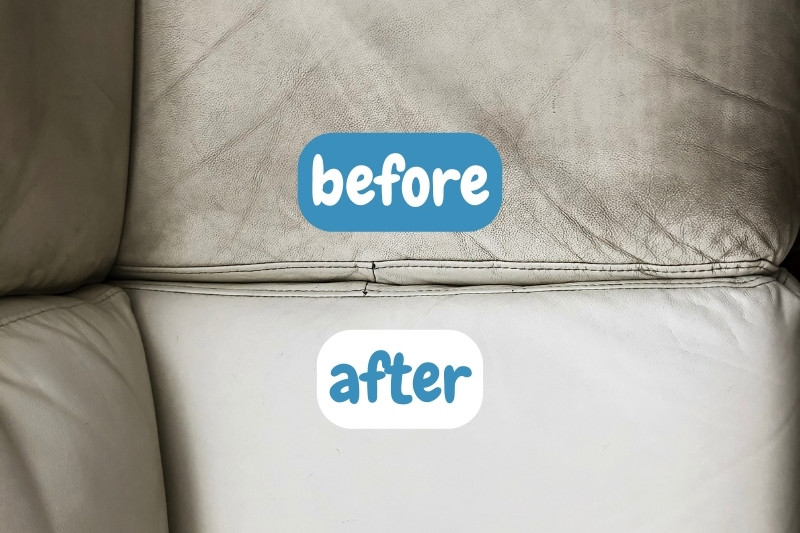
If your sofa, armchair or headboard is looking especially grubby, it might be time for a deep clean.
The good news is, you shouldn’t need to do this frequently, provided you keep up with the maintenance cleans. In fact, once per quarter is generally often enough.
You can also extend the length of time between cleans by using blankets or fitted covers to protect your upholstery for longer.
This is particularly handy if you have kids or pets that are prone to mess!
Provided the material is water-safe, use the following method to deep clean your upholstery:
Step 1: Vacuum up loose debris
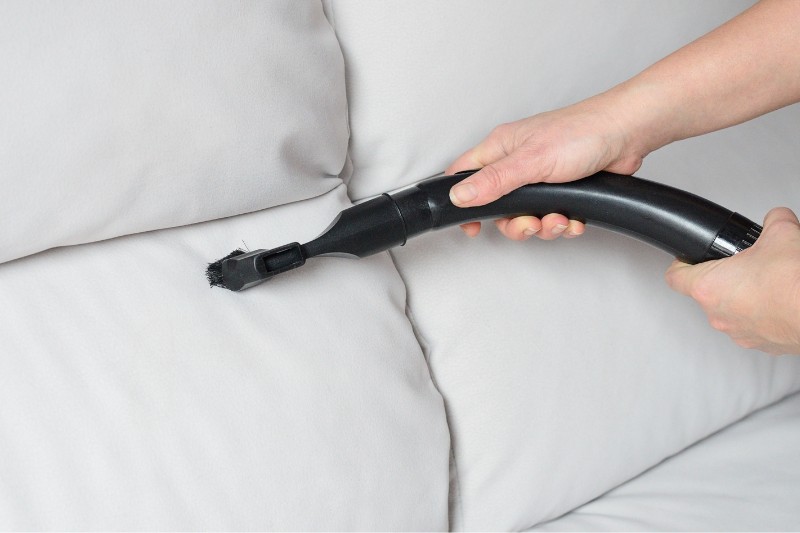
Before you start cleaning, always vacuum first to remove any crumbs, pet hair and other dirt. This will stop it getting pushed further into the fabric fibres, making it much harder to remove.
It will also stop you spreading the grime around and potentially creating a sizeable stain.
If the cushions are removable, take them off and vacuum them individually. Then vacuum the area underneath them, where dust and debris tends to gather over time.
Otherwise, use the crevice tool on your vacuum cleaner to suck up dirt particles in hard-to-reach areas.
Step 2: Spot treat visible stains
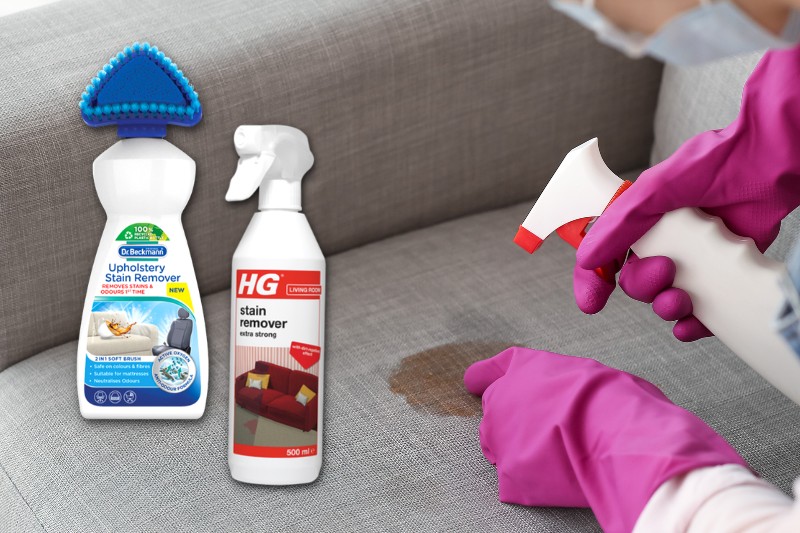
Next, check the fabric for any stains that need pre-treating. This is very important if you’re going to steam clean, as the heat could end up setting them into the fabric.
Work stuck-on grime, including dried food spillages or sticky residue, out of the fibres first. You can do this by gently scraping it free with a blunt butter knife or spoon. You can then start treating the stain.
There are various products that you can try. HG’s Extra Strong Stain Remover for Carpets & Upholstery and Dr. Beckmann Upholstery Stain Remover are good options.
Or you can use washing up liquid diluted with lukewarm water or a 50:50 white vinegar and water solution. Dab the stain with a clean sponge, then blot with kitchen paper until it stops transferring.
Tip: try out your chosen stain remover on a discreet area first to check for colour fastness.
Step 3: Steam clean to kill germs (optional)
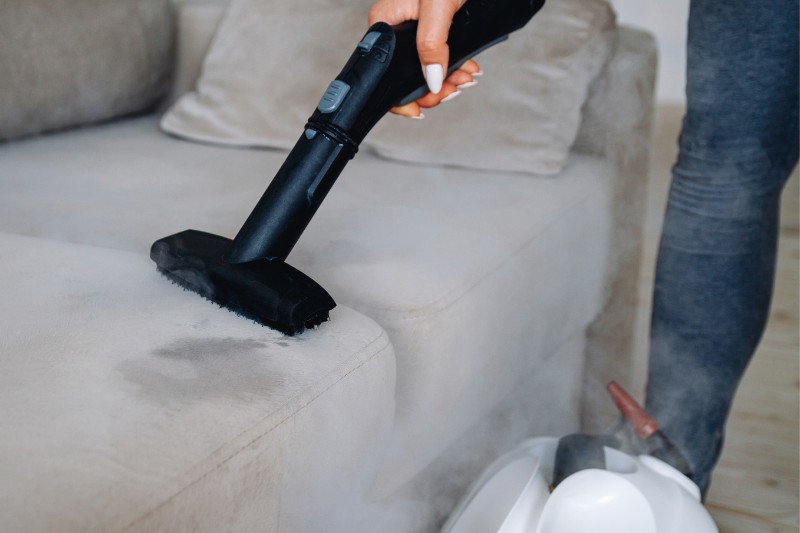
If you have a steam cleaner on hand, run it over your sofa cushions at this stage. This will help to kill any lingering germs, dust mites and other allergens, and banish deep-rooted odours. Otherwise, move onto step 4.
Step 4: Wash with upholstery cleaner & rinse
Lastly, add 1 tsp of clear washing up liquid, to a bucket of lukewarm water and mix until sudsy.
Then dip a clean, lint-free microfibre cloth into the solution. Wring it out slightly, then clean down your sofa from top to bottom.
Pay extra attention to the armrests, bottom panel and the upper cushions where you lean. These areas tend to get the most dirty!
Just be careful not to soak the fabric, as you don’t want excess liquid seeping into the filling. If you’re worried, pour the solution into a spray bottle and lightly spritz it onto the fabric instead.
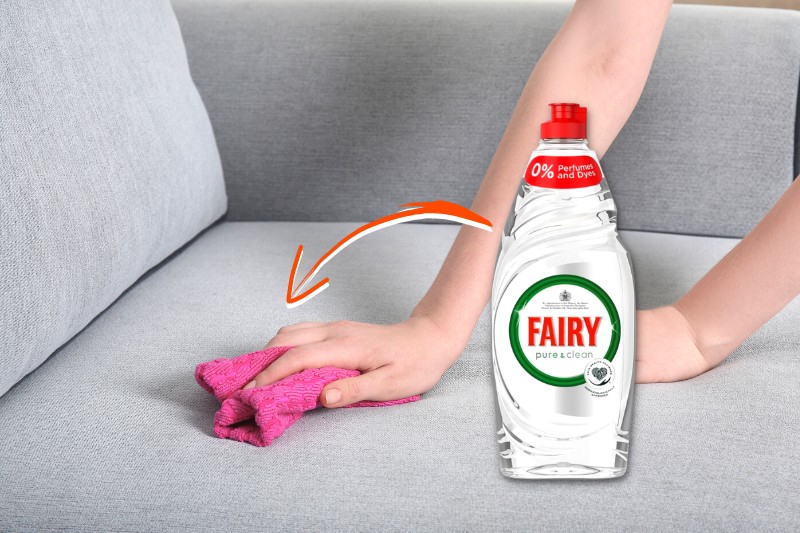
Next, use a microfibre cloth to spread the mixture around, then clean in circular motions. Finish by wiping the sofa down with a clean, damp cloth to remove any leftover soap residue.
Leave it to air dry fully before use. This may take several hours. You can also set up a fan or dehumidifier nearby to help speed up the process.
Or if you have a wet and dry vacuum cleaner, use it suck the excess moisture and any remaining dirt out.

A proud Yorkshire lass with a love for movies, music and cosy nights in! Once a self-confessed avoider of cleaning, she’s always on the lookout for new ways to make household chores as quick and simple as possible.
